As you explore sensory toys for kids, consider a comprehensive approach that incorporates textured play, tactile experiences, and calming tools to support social-emotional and cognitive development. Introduce your toddler to a variety of textures, shapes, and colors to stimulate their senses and foster sensory integration. Calming toys, such as weighted items and soothing toys, can help regulate anxiety and promote relaxation. Fidget toys and shapes and learning toys can enhance focus and cognitive development. By incorporating these toys into your preschool classroom or home environment, you'll provide a holistic foundation for your child's overall growth and well-being, and there's more to discover.
Key Takeaways
- Sensory integration and development are crucial for healthy brain function and regulation of emotions and behavior in children.
- Textured play and tactile toys provide a range of sensations and stimulate exploration, promoting sensory integration and overall development.
- Weighted items offer deep pressure stimulation, reducing anxiety and stress, and improving focus and attention in children with sensory processing needs.
- Calming and soothing toys provide comfort and relaxation, reducing stress and anxiety in children, and promoting social-emotional development.
- Textured toys, shapes, and learning toys support cognitive development, fine motor skills, and hand-eye coordination in children, particularly those with special needs.
Textured Play for Sensory Experience
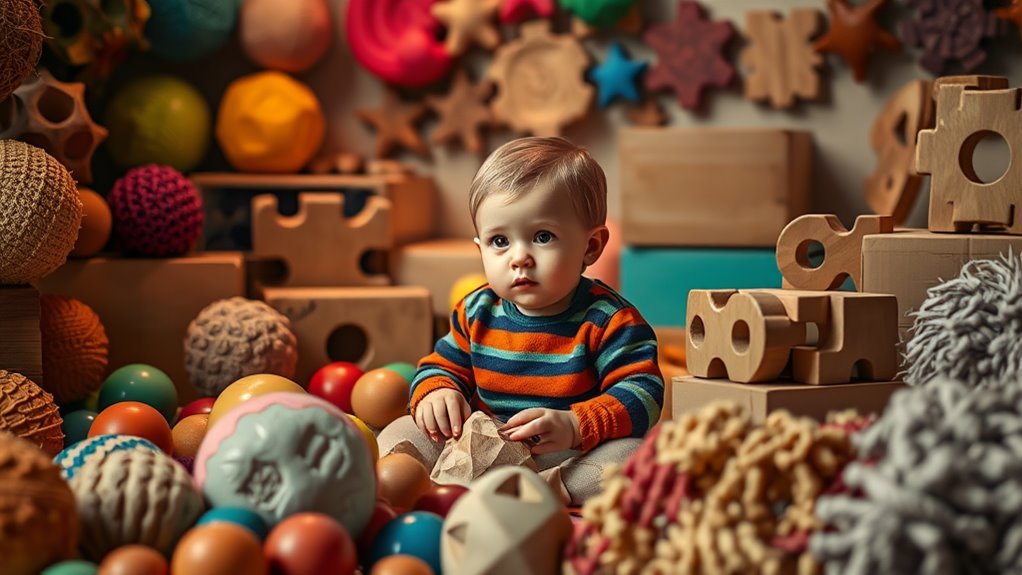
In the gentle rhythm of play, textured toys come alive, awakening the senses and nurturing the developing child. As a parent or caregiver, you play a vital role in providing your child with sensory experiences that stimulate their senses and encourage exploration. Textured play for sensory experience is a powerful tool for promoting sensory integration and overall development.
You can start introducing textured toys to your infant as early as six months, with soft toys featuring different textures that stimulate their senses and encourage grasping. As your child grows, you can introduce teething rings, musical instruments, and building blocks that offer tactile and visual stimulation. Textured balls and toys help develop hand strength and dexterity, while gentle sound-making toys enhance auditory development.
To take your sensory play to the next level, consider using sensory integration tools like sensory integration balls and texture mats. These tools provide a variety of textures and stimulation, helping your child develop the skills they need to navigate the world. By incorporating textured play into your daily routine, you can help your child develop the sensory integration skills they need to succeed in life.
Shapes and Learning Toys
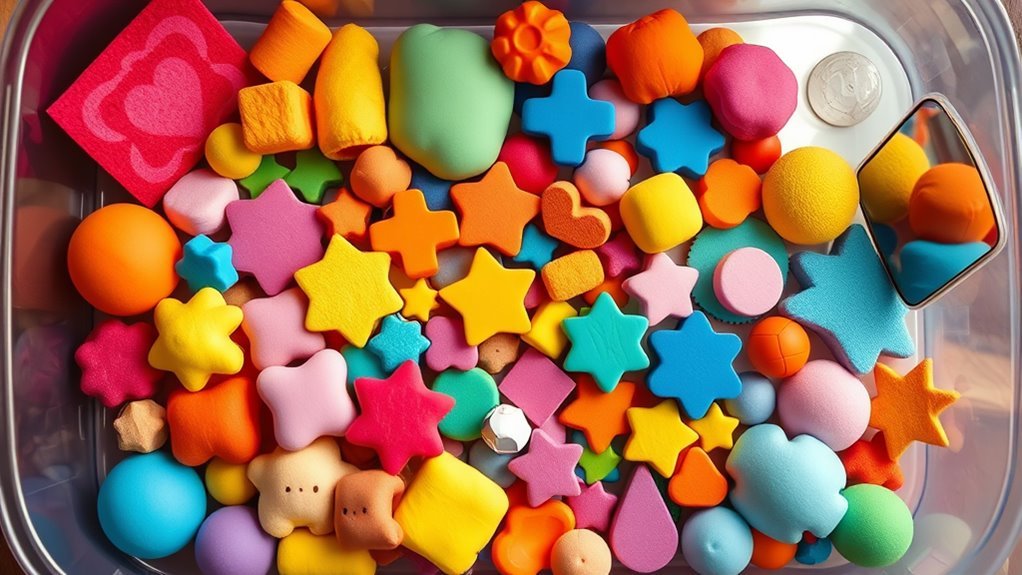
As you continue to nurture your child's sensory development, it's time to introduce shapes and learning toys that will further stimulate their senses and encourage exploration. Developing shape recognition and sorting skills is a crucial aspect of their cognitive growth. To achieve this, you can use a variety of toys that cater to different learning styles.
- Shape sorters with various blocks and slots to teach shape recognition and develop hand-eye coordination.
- Toys with 6 blocks that fit into corresponding shape slots to enhance fine motor skills and hand-eye coordination.
- Shape boxes with hidden compartments to identify shapes using touch, promoting tactile learning.
These toys not only aid in shape recognition but also develop fine motor skills, hand-eye coordination, and problem-solving abilities. They're perfect for enhancing your child's cognitive development and preparing them for future academic success. Moreover, these toys can be used in various settings, such as preschool classrooms, to create a holistic learning environment. By incorporating these shapes and learning toys into your child's playtime, you'll be fostering a lifelong love for learning and exploration.
Calming Tools for Anxiety Management
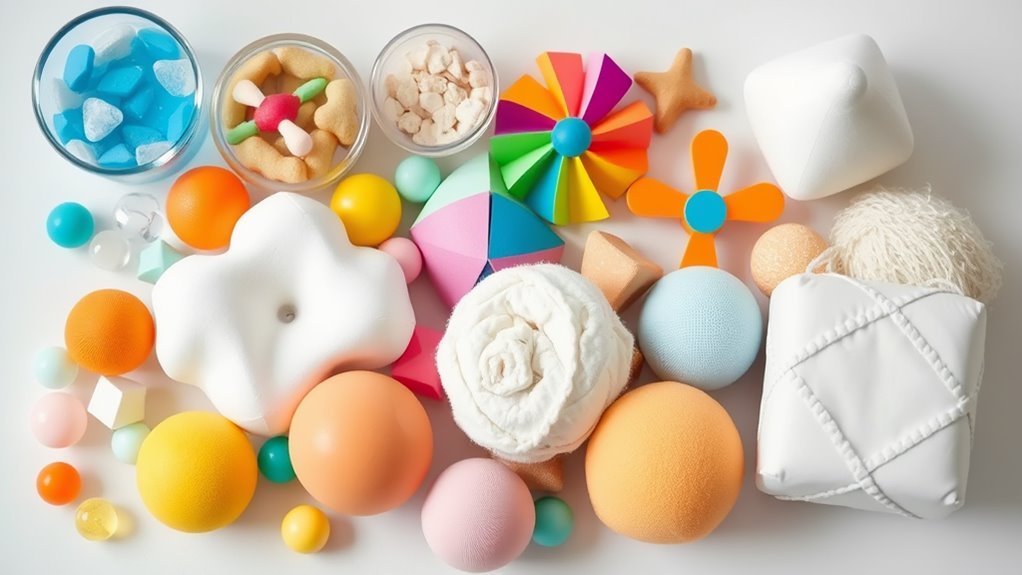
As you navigate the complex world of anxiety management for your toddler, it's essential to explore a range of calming tools that can provide comfort and relief.
By incorporating sensory calming techniques, weighted blankets, and other innovative strategies into your child's daily routine, you can help them develop essential coping skills and manage anxiety more effectively.
Calming Tools for Anxiety
Anxiety can be a suffocating shroud, wrapping around the mind and body, making it difficult to breathe, think, or feel. To regain control, you can utilize calming tools that promote relaxation and reduce anxiety symptoms.
- Deep Breathing: Inhale deeply into your lower abdomen for four counts and exhale for six counts, repeating for several minutes to calm your physiological symptoms.
- Mindful Breathing Exercises: Focus on your breath to refocus away from anxious thoughts and attend to the present moment.
- Progressive Muscle Relaxation: Tense and relax each muscle group progressively to reverse your body's fight-or-flight response.
Weighted Blankets for Relief
Embracing the therapeutic benefits of weighted blankets has become increasingly popular as a calming tool for anxiety management, offering a gentle yet profound sense of security and relaxation that can be tailored to individual needs.
You can harness the power of weighted blankets for anxiety relief and sleep improvement by understanding how they work. Deep pressure stimulation provides a sense of calm, mimicking the experience of being held or hugged, similar to acupressure and massage. This controlled pressure releases neurotransmitters serotonin and dopamine, associated with feelings of calm and well-being, while decreasing cortisol, the stress hormone, helping the body enter 'rest mode'.
Sensory Calming Techniques
Engaging in sensory calming techniques can be a powerful tool for managing anxiety and promoting relaxation in children, and incorporating these activities into daily routines can have a profound impact on overall well-being. By providing children with the right tools and strategies, parents and caregivers can help them develop the skills they need to regulate their emotions and behaviors.
- Deep Pressure and Movement: Try techniques like rocking slowly over a ball on the stomach, swinging in a circular motion with an adult, or using a "move and sit" therapy ball during classroom activities. These activities provide deep pressure input, which can be calming and organizing for the body.
- Tactile Stimulation: Use tools like fidget spinners, stress balls, or textured objects to provide tactile input and distraction. You can also try activities like brushing over arms, back, legs, and head with gentle pressure or using hand fidgets like play dough or Thera-putty.
- Vestibular and Auditory Stimulation: Create a dark space in a tent or use a body sock for sensory comfort, or use calming music or gentle massages to promote relaxation. Noise-canceling headphones or calming ear buds can also be effective in reducing auditory overload.
Social and Emotional Development Toys

Your child's social and emotional development is a journey of incredible growth, where their capacity to recognize, understand, and manage emotions evolves with each passing day. As a parent, you want to empower your child with the tools they need to navigate this journey with confidence and emotional intelligence. One way to do this is by providing toys that foster social and emotional development.
Toys like DUPLO Town Buildable People with Big Emotions and Big Feelings Pineapple Deluxe Set help kids recognize and label emotions, teaching them to understand and describe feelings.
Expression Babies Plush Dolls and Emotiblocks encourage nurturing and empathy skills, while Playfoam Shape & Learn Feelings helps kids build faces and match expressions to real faces, promoting emotional recognition and creativity.
As you choose toys for your child, consider those that promote empathy and perspective-taking, such as Puppets and Police Costume. These toys help kids take on the feelings and actions of another person or character, building their emotional intelligence. By incorporating these toys into your child's playtime, you can support their social and emotional development, giving them the skills they need to thrive in all areas of life. By being intentional with your choices, you can help your child develop a strong foundation for emotional intelligence and a lifetime of happiness.
Fidget Toys for Focus

Fidget toys have become a valuable tool for children with ADHD and autism, offering a discreet way to regulate their nervous system and improve focus. By incorporating fidget toys into your child's daily routine, you can help them stay on track and maintain a sense of calm. Here are three key benefits of using fidget toys for focus:
| Benefit | Description |
|---|---|
| 1 | Improved Focus: Fidgets help children with ADHD stay focused during lessons and activities by providing necessary movement. |
| 2 | Reduced Stress: Consistent use of fidget toys can reduce stress and increase focus in autistic children. |
| 3 | Enhanced Fine Motor Skills: Toys like putty and grip strengthen fine motor skills while serving as fidgets. |
When introducing fidget toys to the classroom, it's essential to consider teacher approval, durability, and quiet nature. Look for fidgets that can be integrated into learning activities, such as math and phonics, and are designed to be low-distraction options. By incorporating fidget toys into your child's daily routine, you can help them develop better focus and reduce stress. Remember to consult with teachers before introducing fidget toys to the classroom to ensure they align with your child's needs and the classroom environment.
Tactile Toys for Special Needs
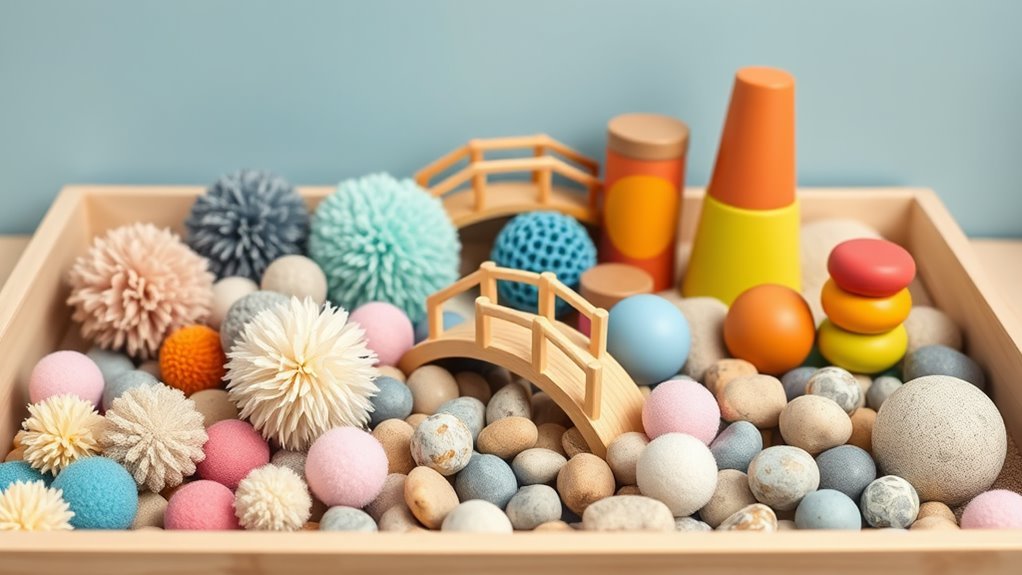
As you explore the world of tactile toys for kids with special needs, you'll discover a wealth of options that cater to various sensory needs and preferences. By incorporating texture and tactile fun into your child's daily routine, you can help build tactile skills fast and enhance their sensory experience.
From anxiety relief to cognitive development, tactile toys offer a holistic approach to supporting your child's overall well-being.
Texture and Tactile Fun
Numerous tactile stimulation toys exist, catering to the diverse needs of toddlers with special needs, providing a sensory experience that fosters cognitive development and engagement. You can explore the world of texture and tactile fun by engaging in activities that stimulate your sense of touch.
You can start by incorporating sensory toys into your daily routine, such as sensory balls with different textures, sizes, and shapes, or sensory putty, stress balls, and squishy toys for tactile input. You can also use sensory brushes with soft bristles for deep pressure stimulation or vibrating toys and pillows for varied tactile sensations.
- Texture exploration: Use your hands to explore different textures, such as sandpaper, velvet, or bumpy fabric, to develop your sense of touch.
- Sensory integration: Engage in activities that combine multiple senses, such as touching and smelling different textures, to enhance your sensory integration.
- Tactile learning: Use tactile toys and materials to learn about shapes, sizes, and materials, and develop your problem-solving skills.
Building Tactile Skills Fast
When it comes to fostering a strong foundation for tactile skills, incorporating sensory toys into your daily routine can be a game-changer for toddlers with special needs. By building tactile skills quickly, you can enhance their sensory experience and promote overall development.
To start, focus on tactile stimulation for toddlers through toys like textured blocks, kinetic sand, and spinning tops. These items provide various tactile experiences that can be tailored to individual preferences and sensitivities. You can also incorporate sensory brushes, weighted blankets, and fidget toys to offer deep pressure stimulation and channel restless energy.
For enhanced tactile skills, try stacking towers, nest cups, and sensory putty. These toys help refine hand-eye coordination and fine motor skills. Additionally, sensory balls with different textures, sizes, and shapes promote hand-eye coordination and tactile input.
Enhancing Sensory Experience
To enhance the sensory experience of children with special needs, a carefully curated selection of tactile toys can provide a depth of stimulation that fosters deep regulation, learning, and development. By incorporating tactile toys into daily routines, you can significantly impact a child's sensory integration, motor skills, and overall emotional well-being.
Here are a few key items to consider:
| Type of Tactile Toy | Benefits |
|---|---|
| Textured Fidgets | Provide various textures for tactile exploration, enhancing sensory integration and fine motor skills |
| Sensory Mats | Offer different textures and sensations for kids to engage with, promoting sensory motor development and relaxation |
| Tactile Discs | Offer a range of tactile experiences with different materials and textures, supporting learning and problem-solving skills |
When selecting tactile toys, consider the child's individual needs and preferences. Enhancing sensory experience through tactile integration is a crucial aspect of supporting sensory motor development. By incorporating a variety of tactile toys into daily routines, you can help children with special needs develop a deeper understanding of their senses and improve their overall sensory integration.
Weighted Items for Deep Pressure
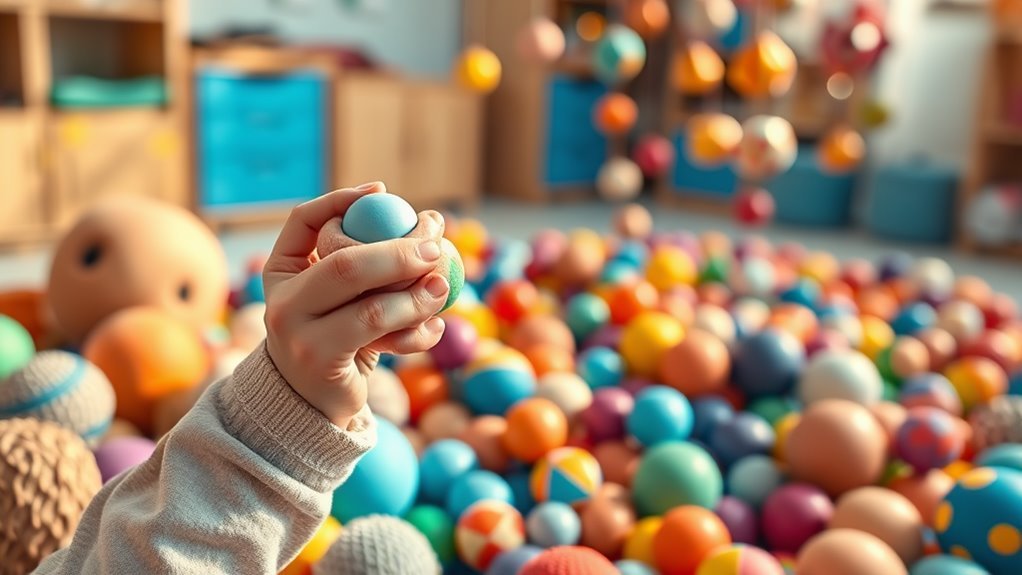
Using weighted items can be a game-changer for toddlers with sensory processing needs, providing a sense of deep pressure that calms and soothes the nervous system. As you explore the world of weighted items, you'll discover a range of options designed to deliver deep pressure stimulation, including weighted blankets, vests, lap pads, stuffed animals, and scarves. Each item offers a unique way to experience deep pressure, allowing you to tailor your sensory experience to your needs.
When it comes to benefits, weighted items can have a profound impact on autistic children. By providing deep pressure stimulation, these items can reduce anxiety and stress, improve focus and attention, and enhance sensory integration. Weighted items can also promote better sleep quality and increase feelings of security, providing a sense of safety and comfort.
To ensure safe and effective use, always supervise the use of weighted items, choose items with appropriate weights, and follow specific washing and care instructions.
Sensory Integration Tools and Therapy
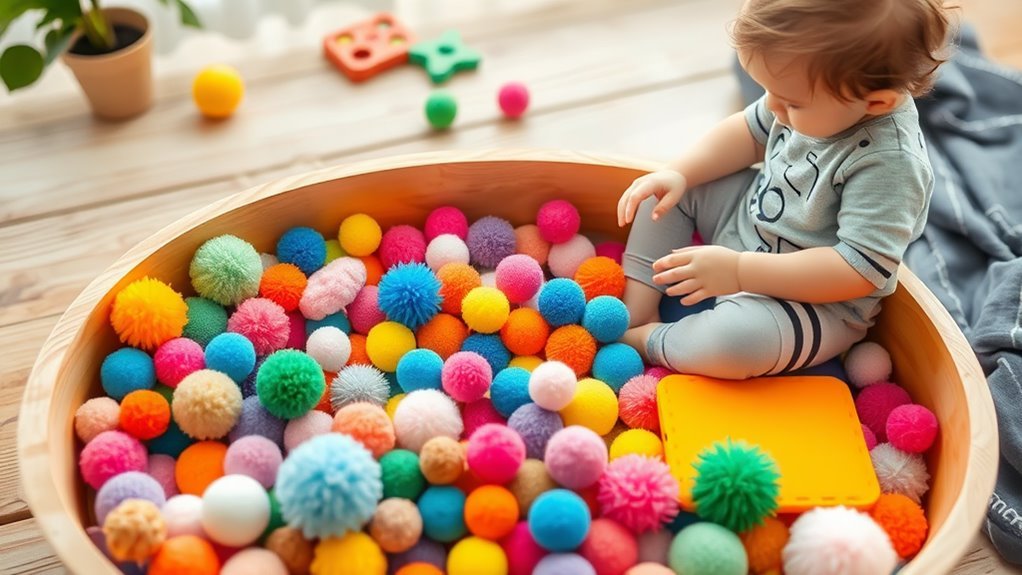
- Deep Pressure Stimulation: Use tools like the Wilbarger Brush or a weighted blanket to provide deep pressure stimulation, helping to regulate sensory processing and reduce anxiety.
- Sensory Integration Activities: Engage your child in activities that promote sensory integration, such as brushing, joint compressions, or swinging.
- Vestibular Stimulation: Use tools like swings or trampolines to provide vestibular stimulation, helping to integrate proprioceptive and vestibular senses.
Calming and Soothing Toys
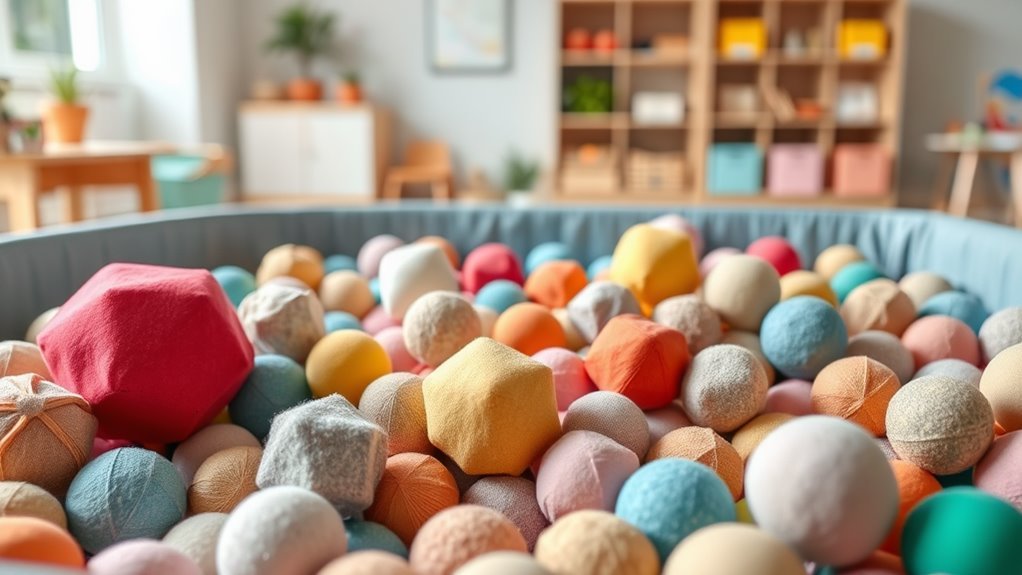
Immerse your child in a world of tranquility with calming and soothing toys, expertly crafted to provide a sense of security and relaxation. As a parent or caregiver, you understand the importance of creating a calming environment for your child to thrive. Calming toys for kids are designed to provide sensory relief tools that can help reduce stress and anxiety, promoting a sense of well-being.
Consider investing in sensory relief tools like calming sensory tents, weighted toys, and tactile pillows with gentle vibration. These toys offer a range of calming effects, from deep pressure stimulation to soothing vibrations and textures.
You can also explore visual and auditory calming toys, such as mood lighting, night lights, and cuddly toys with soothing sounds.
Essential Toys for Preschool Classrooms
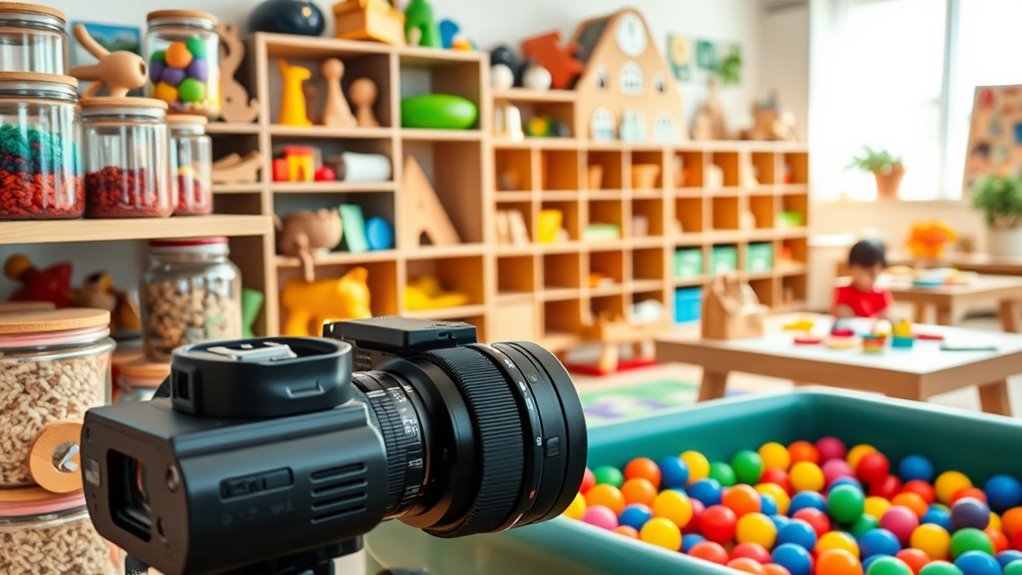
Creating a well-rounded preschool classroom is a delicate balance of stimulating and calming elements, as it's essential to cater to the diverse needs of young learners. When selecting toys for the classroom, it's crucial to consider the various learning styles and abilities of students. By incorporating a mix of learning toys, sensory integration tools, and social-emotional development toys, you can create an engaging and supportive environment that fosters growth and development.
To achieve this balance, consider the following essential toys for preschool classrooms:
| Toys | Benefits |
|---|---|
| Alphabet and number blocks | Develops early literacy and numeracy skills |
| Shape sorters and puzzles | Enhances problem-solving abilities |
| Sensory balls and texture mats | Provides tactile exploration and sensory integration |
When selecting learning toys, look for those that promote hands-on learning, problem-solving, and critical thinking. For social-emotional development, incorporate toys that encourage empathy, cooperation, and self-awareness. By integrating these toys into your preschool classroom, you can create a holistic learning environment that caters to the diverse needs of your students, promoting healthy sensory integration, learning, and social-emotional development.
Conclusion
You're wrapping up your exploration of sensory toys for little ones, and it's time to reflect on the treasures you've uncovered. Embracing your inner "sensory concierge," you're providing a haven for tactile exploration, teaching shapes and learning through touch, and calming anxious nerves with soothing tools. By "enriching the atmosphere," you're nurturing emotional development, focus, and calming, all while being a devoted "sensory weaver" in the preschool classroom.
